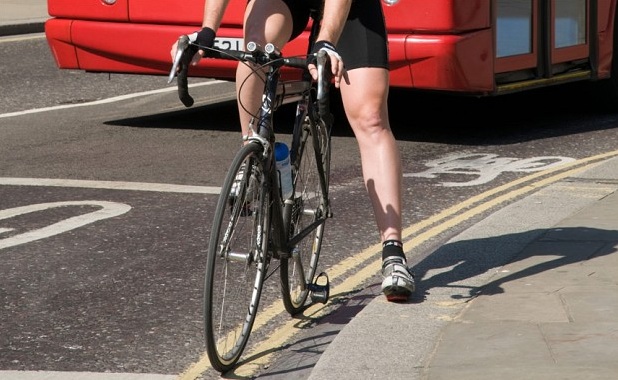Nobody appreciates riding on asphalt more than cyclists. Some asphalt surfaces are as slick as glass and you feel like you’re on rails. Some have energy sucking qualities that make you work. Power, speed and heart rate increases just to reach a comfortable cruising speed. You may not appreciate how it’s affecting you at first, but as the miles pile up, you begin to notice. A little awareness can go a long way.

The Asphalt Life
Asphalt surfaces are not merely rough or smooth, they are complex formulas revealing their true nature to cyclists when the rubber meets the road. You’ve probably heard other cyclists refer to a certain road as “that rough stretch between point A and point B.” It’s because cyclists typically understand asphalt conditions better than anyone else, and talk about them more often.
What We Know From Cars
Tests performed by the Department of Transportation show that rough asphalt can produce nearly twice as much rolling resistance as smooth asphalt, causing cars to use 10-percent more fuel at a constant speed. You can imagine what it does to bikes.
The Output
Cars engines produce roughly 200-t0-300 horsepower. Your heart is the engine of a bike, typically producing less than one horsepower. So the cyclist is immediately aware of the resistance or ease offered up by various road surfaces. While the driver of the car may find asphalt to be a minor detail, cyclists who use their heart and muscles react to asphalt on a more intimate scale.
Exposed Aggregate
Exposed aggregate is a term typically applied to concrete surfaces, but it’s also recognized in asphalt. You’ve probably encountered it many times; rocks embedded in the asphalt, but not completely flush with the surface. It’s like rough sandpaper. the degree of exposed rocks can vary, but it’s like riding on rocks — because it is. It’s not always possible to avoid exposed aggregate, and you’ve got to do your best to just get through it somehow.
The Despicable Chip Seal
Chip seal is universally despised and feared by cyclists. You’ve no doubt encountered it yourself at some point. It’s nasty, with millions of sharp, loose rocks and dust. Chip seal is a base of soft asphalt overlaid with crushed stone aggregate. Cyclists dislike chip seal because it’s a rough, dusty ride. It’s slow going, and if you ride on it continuously, it can shred your tires, motivation and moral.
Trucks and Cyclists
Chip seal is so bad on performance that some trucking lines factor chip seal roads into their fuel calculations because the higher rolling resistance of chip seal consumes more fuel. Cyclists feel the roughness through their hands and butts, the resistance in the heart, lungs and legs.
That Smooth Strip
Chip seal doesn’t always extend the full width of the road, you’ve probably seen it before, a smooth strip alongside the chip seal. This is often the solution to riding on chip seal. It’s sometimes done by conscientious highway planners on purpose. Chip sealing the main traffic lane while preserving a strip along the shoulder saves money and gives cyclists a lane to ride on.
Speak Out
Some local Department of Transportation officials are aware of issues with chip seal and cycling. So it’s important for cyclists to speak up and express concerns in the planning stages of local repaving projects. If you’re in a position to do so, bring it up.
Cycle Paths
Cycle path surfaces are a different animal. They are designed differently from vehicle surfaces to provide the best surface available to bikes. Studies have been done that outline the best materials and procedures for bike paths.
Cement
Cement is typically not found on public roadways to any extent. Some cyclists swear that cement is a superior ride to asphalt, while others hate it. Cement can be rough, because road planners make it that way, with slight grooves to give cars better traction, and to prevent it from icing up. This type of grooved surface can cause your bike to wander from side to side, and is generally considered less desirable than pavement. In addition, cement may have regular seams that can jar your teeth.
Tips for Riding on Rough Stuff
The concept has always been that the more tire pressure, the less rolling resistance tires produce. While this is true for things like velodromes and glassy pavement, high-pressure bike tires dont work so well on exposed aggregate or chip seal. Some cyclists swear that you get a better ride on rough stuff by lowering the recommended tire pressure a few pounds in the front, and a little more in the back; you’ll need to experiment with it. Don’t lower it enough to get a pinch flat.
Relax and Ride
Start by relaxing the muscles in your face and shoulders, your body will follow. Keep your elbows slightly bent. Locking your elbows is a recipe for disaster. Bending your elbows allows for quicker and more fluid steering of your bike over rough terrain. Hold onto the hoods or tops and sit on the rear of the saddle. Loosen your grip on the handlebars. A tight grip causes fatigue in your shoulders and hands. It can also cause you to oversteer if you hit slick gravel, and wash out your front end.
Pick Your Line
You’ll often see narrow lines of smooth pavement between exposed or rough aggregate; use them to your advantage. When one peters out, find another to ride on. It can require some studying to find them, but they’re almost always out there, waiting for you to ride on.
Gearing
High cadences tend to bounce you around on the bike. Try to maintain a higher speed – depending on how rough the road is, to help you glide over rough patches. Keep your cadence lower and pedal in a higher gear when possible.